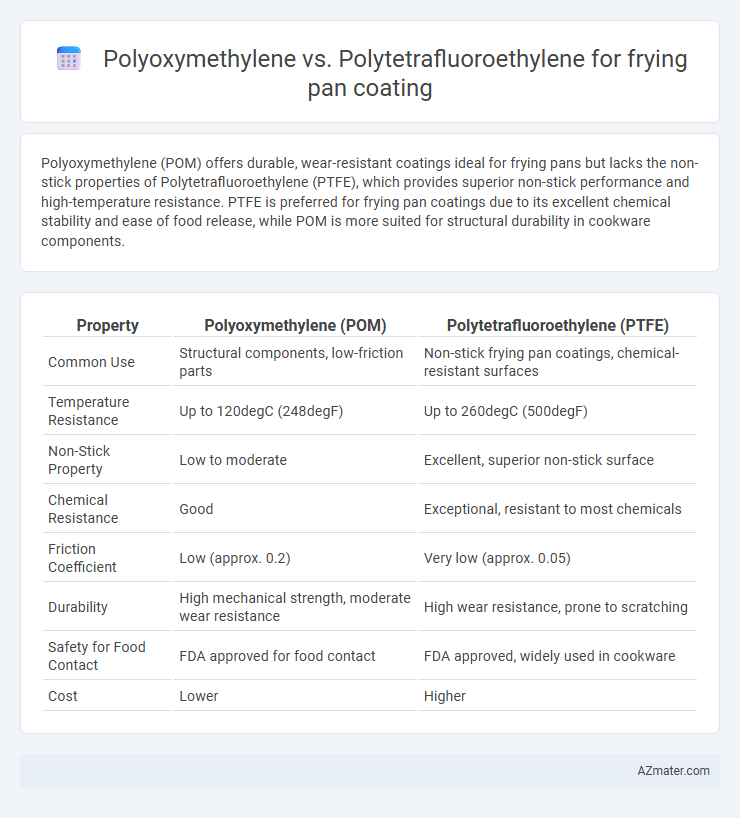Polyoxymethylene (POM) offers durable, wear-resistant coatings ideal for frying pans but lacks the non-stick properties of Polytetrafluoroethylene (PTFE), which provides superior non-stick performance and high-temperature resistance. PTFE is preferred for frying pan coatings due to its excellent chemical stability and ease of food release, while POM is more suited for structural durability in cookware components.
Table of Comparison
| Property | Polyoxymethylene (POM) | Polytetrafluoroethylene (PTFE) |
|---|---|---|
| Common Use | Structural components, low-friction parts | Non-stick frying pan coatings, chemical-resistant surfaces |
| Temperature Resistance | Up to 120degC (248degF) | Up to 260degC (500degF) |
| Non-Stick Property | Low to moderate | Excellent, superior non-stick surface |
| Chemical Resistance | Good | Exceptional, resistant to most chemicals |
| Friction Coefficient | Low (approx. 0.2) | Very low (approx. 0.05) |
| Durability | High mechanical strength, moderate wear resistance | High wear resistance, prone to scratching |
| Safety for Food Contact | FDA approved for food contact | FDA approved, widely used in cookware |
| Cost | Lower | Higher |
Introduction to Polyoxymethylene (POM) and Polytetrafluoroethylene (PTFE)
Polyoxymethylene (POM) is a high-performance thermoplastic known for its excellent mechanical strength, rigidity, and low friction, making it suitable for various industrial applications but less common in cookware coatings. Polytetrafluoroethylene (PTFE), widely recognized as Teflon, offers exceptional non-stick properties, high chemical resistance, and thermal stability, which are essential for frying pan coatings to ensure easy food release and durability. While POM excels in structural uses, PTFE dominates the frying pan market due to its superior non-stick surface and resistance to high cooking temperatures.
Chemical Structure and Composition
Polyoxymethylene (POM), a thermoplastic polymer composed of repeating -CH2O- units, offers excellent mechanical strength but limited thermal stability for frying pan coatings. Polytetrafluoroethylene (PTFE), characterized by a carbon-fluorine backbone with strong C-F bonds, provides superior chemical inertness, non-stick properties, and high heat resistance ideal for cookware surfaces. The fluoropolymer structure of PTFE enables it to withstand temperatures up to 260degC, whereas POM decomposes at lower temperatures, limiting its use in high-heat applications like frying pans.
Thermal Stability and Heat Resistance
Polyoxymethylene (POM) has limited thermal stability with a maximum service temperature around 100degC to 120degC, making it unsuitable for high-heat frying pan coatings due to potential degradation. Polytetrafluoroethylene (PTFE) exhibits superior heat resistance and thermal stability, maintaining integrity at temperatures up to 260degC to 300degC and offering excellent non-stick properties under high cooking temperatures. PTFE's ability to withstand thermal stress without breaking down makes it the preferred coating material for frying pans requiring durability and safety during prolonged high-temperature use.
Non-Stick Properties Comparison
Polytetrafluoroethylene (PTFE) offers superior non-stick properties compared to polyoxymethylene (POM) in frying pan coatings due to its low surface energy and high chemical inertness, which prevent food adhesion effectively. PTFE's high thermal stability up to 260degC ensures durability under typical cooking conditions, whereas POM has lower thermal resistance and tendency to degrade at frying temperatures. The hydrophobic nature of PTFE combined with its smooth surface texture provides exceptional ease of food release, making it the preferred choice for non-stick cookware applications.
Durability and Scratch Resistance
Polyoxymethylene (POM) frying pan coatings offer high mechanical strength and excellent wear resistance but are less effective against heat-induced degradation compared to Polytetrafluoroethylene (PTFE), which excels in thermal stability and non-stick properties. PTFE coatings provide superior scratch resistance and durability in high-temperature cooking environments, maintaining performance without peeling or cracking. While POM may offer rigidity, PTFE remains the preferred choice for frying pan coatings due to its longevity and resilience under frequent use.
Food Safety and Regulatory Compliance
Polytetrafluoroethylene (PTFE) is widely preferred for frying pan coatings due to its excellent non-stick properties, high heat resistance up to 260degC, and compliance with FDA and EFSA food safety regulations, ensuring minimal chemical migration into food. Polyoxymethylene (POM) lacks the thermal stability required for direct food contact at frying temperatures and is generally not approved for surface coatings in cookware due to potential decomposition and safety concerns. Regulatory agencies prioritize materials like PTFE that demonstrate durability, inertness, and proven safety profiles under cooking conditions.
Performance Under High-Temperature Cooking
Polytetrafluoroethylene (PTFE) outperforms polyoxymethylene (POM) as a frying pan coating due to its exceptional thermal stability, maintaining integrity at temperatures up to 260degC without degrading. PTFE's non-stick properties and resistance to chemical breakdown under prolonged high-heat exposure ensure superior performance in high-temperature cooking. Conversely, POM's lower thermal resistance, typically up to 120degC, makes it unsuitable for frying pan coatings where sustained heat and safety are critical.
Ease of Cleaning and Maintenance
Polytetrafluoroethylene (PTFE) coatings on frying pans provide superior ease of cleaning and low maintenance due to their non-stick, chemically inert surface that resists residue adhesion and staining. Polyoxymethylene (POM) is primarily used as an engineering plastic rather than a non-stick frying pan coating, making it less relevant for cooking surfaces and typically harder to clean if used in cookware. PTFE's resistance to food buildup and simple wipe-clean properties make it the preferred choice for low-maintenance frying pan coatings.
Cost Efficiency and Manufacturing Considerations
Polyoxymethylene (POM) offers lower material costs and easier machining compared to Polytetrafluoroethylene (PTFE), making it more cost-efficient for frying pan coatings in large-scale production. PTFE provides superior non-stick properties and higher chemical resistance but requires specialized sintering processes that increase manufacturing complexity and expenses. Selecting POM balances budget constraints and manufacturing simplicity, whereas PTFE demands higher investment for premium performance and durability.
Conclusion: Best Choice for Frying Pan Coatings
Polytetrafluoroethylene (PTFE) outperforms Polyoxymethylene (POM) for frying pan coatings due to its superior non-stick properties, high thermal stability up to 260degC, and excellent chemical resistance. POM lacks the necessary heat tolerance and non-stick surface quality, making it less suitable for direct food contact at frying temperatures. PTFE remains the best choice for frying pan coatings, ensuring durability, safety, and optimal cooking performance.

Infographic: Polyoxymethylene vs Polytetrafluoroethylene for Frying pan coating
 azmater.com
azmater.com